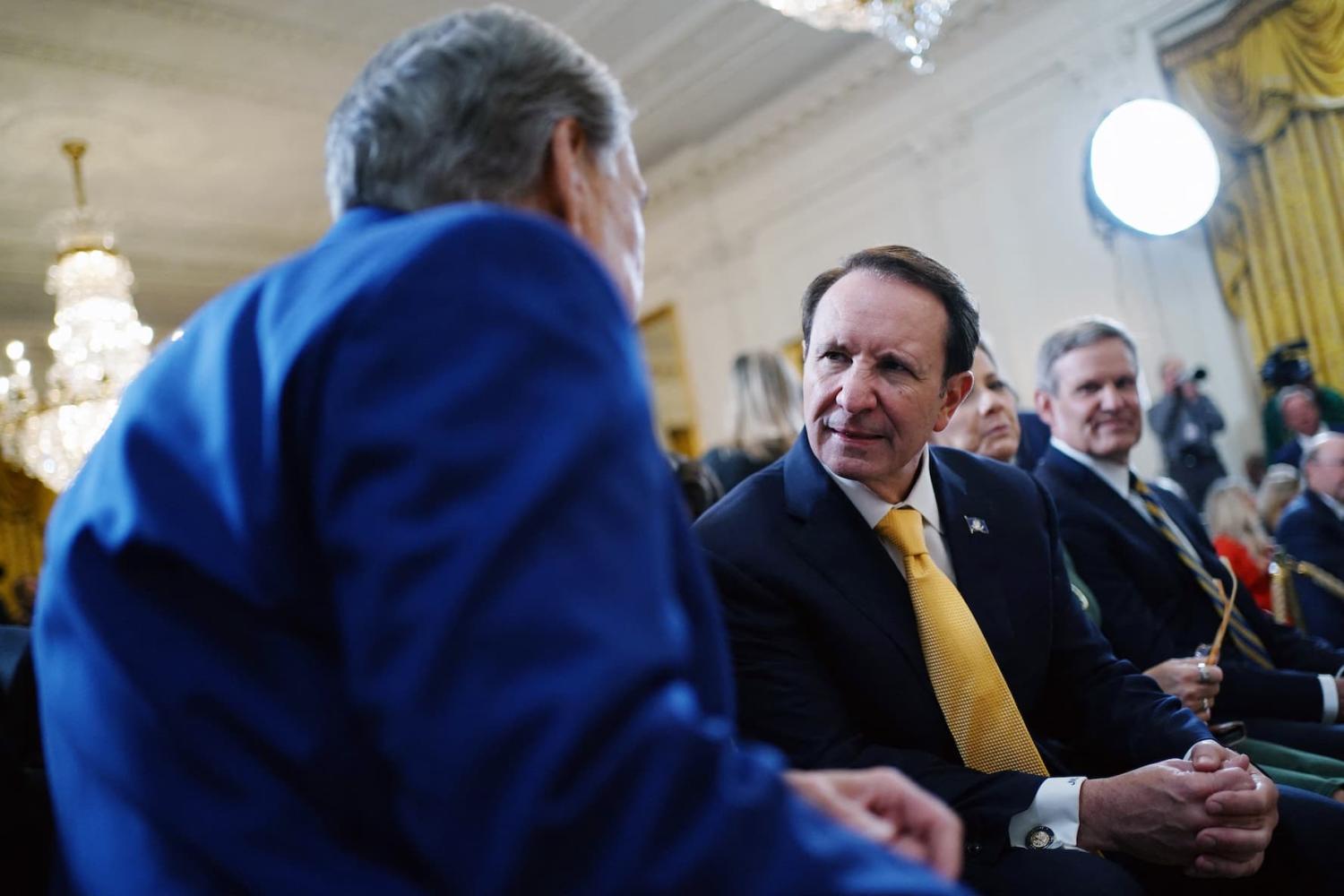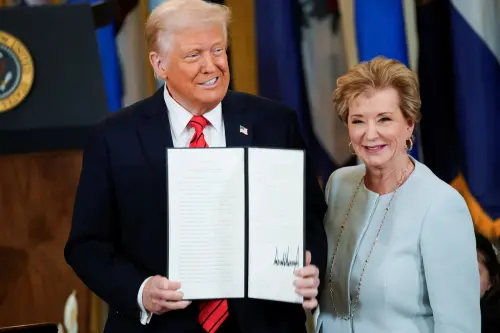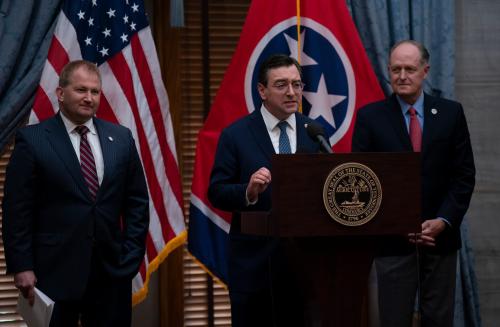May is National Mental Health Awareness Month. The U.S. Department of Education marked the start of the month by terminating a $1 billion grant program that helps schools hire mental health professionals. In this context, it’s worth stepping back to consider how our students are doing and how states might respond to the situation.
The pandemic wreaked havoc on youth mental health in the United States. However, troubling trends in depression, anxiety, and suicidal ideation started well before 2020. The share of high schoolers reporting “persistent feelings of sadness or hopelessness” increased from 28% to 42% between 2011 and 2021, the rate of emergency department visits for self-harm doubled for teenage girls from 2001 to 2020, and suicide rates for young men have steadily climbed since the early 2000s. On multiple measures of youth depression, the U.S. ranks near the bottom of the world. As our colleague Carol Graham put it, “The kids are not OK.”
Student well-being is a complex, multifaceted issue that can be difficult for policymakers to tackle. State and local leaders might find this even truer in the months and years ahead if federal resources become scarce. We wanted to get a sense of how state leaders are thinking about students’ well-being and what policy responses they might have in mind. For answers, we looked to governors’ “state of the state” (SOTS) addresses (or inaugural addresses for incoming governors). As of now, 49 governors have delivered an address, from Idaho Governor Brad Little on January 6 to Minnesota Governor Tim Walz on April 23. SOTS addresses aren’t perfect representations of governors’ priorities or plans. They are political speeches, after all, and governors must work with state legislatures on policymaking. However, SOTS addresses offer a glimpse of governors’ policy priorities for the year ahead that allows for useful comparisons across states.
In this post, we analyze governors’ 2025 annual remarks with a focus on proposals related to youth well-being (i.e., not just academics). We found four topics of particular interest to governors—mental health services, school safety, cell phone bans, and school meals—with some commonalities and some differences in how governors are approaching these issues. As Figure 1 illustrates, while Republicans and Democrats were similarly likely to propose cell phone bans or school safety measures, proposals focusing on mental health services or school meals were much more prevalent in Democratic governors’ addresses.
Mental health services
A kid in crisis may be distracted or disengaged and may not be able to focus on their studies, if they are able to get to school at all (…) Tonight, I’m announcing my budget proposal will invest nearly $300 million to provide comprehensive mental health services in schools statewide, including support for peer-to-peer suicide prevention programs and expanded mental health training.
Governor Tony Evers, Wisconsin
[First Lady Marty Kemp] has also been a tireless champion for mental health services. For over a year now, as she has promoted the 9-8-8 suicide and crisis hotline, she has carried this message forward: 'It’s ok, to not be ok.'
Governor Brian Kemp, Georgia
In 2022, three-fourths of public school leaders reported increased concern about youth mental health since the pandemic had started. Children spend many of their waking hours in schools, providing opportunities for schools to support students with mental health diagnoses and provide necessary care. However, inadequate funding and inadequate access to licensed mental health professionals are often cited as barriers. During the 2023-24 academic year, there was only one psychologist for every 1,065 students in K-12 schools across the United States; while school counselors can also provide general mental health support, counselor staffing levels are also low, at about one counselor for every 376 students. Less than half of school leaders agreed that they are able to provide mental health services to all students in need.
Many Democratic governors proposed expanding funding and programming to create broader access to mental health services. For example, Governor Janet Mills of Maine proposed increased funding for the behavioral health system and screening for behavior issues, complemented by creating the state’s first residential psychiatric treatment facility. Pennsylvania Governor Josh Shapiro proposed expanding insurance coverage for student health and mental health services received in school. Fewer Republicans proposed specific school mental health staffing or screening supports, though many motivated other proposals (outlined below) by a concern for mental health. Exceptions include Governor Brian Kemp of Georgia who highlighted efforts to expand statewide youth mental health services, including promoting crises hotlines.
Research shows that equitable access is key to ensuring that students have the resources they need to lead healthy lives. We still need research on how schools can best implement mental health services for students and overcome challenges related to issues such as a lack of collaboration between teachers and mental health providers.
School safety
At my request, the General Assembly began funding an SRO [School Resource Officer] grant program (…) Fully fund this grant program, so that every public school student in South Carolina will have an officer on campus providing safety for students and teachers and comfort for the parents.
Governor Henry McMaster, South Carolina
We also need safety upgrades like cameras, fences around playgrounds, exterior locks, and fewer access points to secure our school buildings from people who mean harm.
Governor Josh Stein, North Carolina
Amidst concerns for students’ mental health, there is increased concern for students’ safety, especially from school violence and shootings. Many Republican governors advocated for stronger security programming, emphasizing school resource officers (SROs). Governor Greg Abbott of Texas proposed a $500 million investment to better secure school buildings while also pushing for stricter school discipline. South Carolina Governor Henry McMaster asked the General Assembly to continue to fund the SRO grant program to ensure that every public school has an armed, certified full-time SRO. In Georgia, Governor Brian Kemp proposed an additional $159 million investment into strengthening campus security, highlighting the role SROs played in a recent school shooting.
In day-to-day operations, the effectiveness of SROs is mixed and states vary widely in their SRO staffing. When SROs are present in a school, more crimes are reported, but it’s unclear if this is because of increased crime incidence or increased surveillance. When a school adds an SRO, students are more likely to be suspended or expelled and more students are referred to the criminal justice system, with disproportionate increases for Black students, male students, and students with disabilities.
A few Democratic governors also promoted school safety efforts, but their approaches differed. Some focused on technological surveillance, such as North Carolina Governor Josh Stein calling for cameras and fences. Some focused on reduced gun access, such as Hawaii Governor Josh Green connecting new gun safety laws and buybacks to school and neighborhood safety. Research finds external cameras in schools can help students feel safer, though there isn’t strong evidence that they impact safety. Research shows that school safety and reducing school violence is more likely to be improved via mental health and counseling supports coupled with school professional development than by school “hardening” efforts, such as increased SRO presence or school building security enhancements.
Cell phone bans
From bullying to TikTok, there is no reason for any student, at any level, in a Delaware public school, to be using a cell phone in class.
Governor Matt Meyer, Delaware
We got the cell phones out, and the Ten Commandments in.
Governor Jeff Landry, Louisiana
Perhaps no issue saw greater bipartisan support from the governors than banning cell phones in classrooms. Making connections between student mental health and cell phones (particularly the connection between social media accessed on a smartphone and students’ mental health), at least 20 governors either touted existing policies to eliminate phones in classrooms or proposed new bans.
School leaders believe cell phones negatively impact academic performance, and studies and reports from educators indicate that removing personal devices from the classroom eliminates distractions, improves student performance, and reduces student stress and anxiety. Even teens admit social media hurts their mental health. While some parents oppose all-day restrictions to cell phones for fear of not being able to reach their child in an emergency, two-thirds of K-12 parents support bans during class sessions.
States seem to have nearly uniformly moved from the question of whether to ban cell phones to figuring out how to implement policies. Some teachers report that collecting phones at the beginning of class is too time-consuming, or that students are savvy enough to evade any attempts to keep phones away. More research is needed to understand how states can make phone ban policies stick and what effects these bans are having.
School meals
Today, I’m announcing my plan to use Medical Marijuana money to make (…) our free lunch and breakfast programs financially sustainable for years to come. We will also use those funds to make school breakfast in Arkansas completely free.
Governor Sarah Huckabee Sanders, Arkansas
I am excited to work (…) on legislation to ensure that every student attending K-12 public schools receives free breakfast and lunch as part of their basic education.
Governor Bob Ferguson, Washington
Students require a basic level of nutrition to engage with school. Free or reduced-price school meals meet these basic needs for the lowest-income families, alleviating hunger and enabling students to fully engage in learning. When students have access to free school meals, they perform better on tests, are less likely to get suspended, and are more likely to attend school.
Several governors highlighted existing investments in school meals or proposed policies to strengthen their states’ school meals programs. Many proposals aimed to make school lunch or breakfast free for all students. This approach assumes that federal funds will continue to support students eligible for free or reduced-price meals (similar to how a state “free college” program often only pays for any tuition and fees that remain after a student uses the federal Pell grant). However, the federal government’s share of nutrition assistance is up in the air; draft proposals for the upcoming reconciliation bill would remove eligibility for free lunch for many schools, and states would have to spend more to make up the difference and meet universal free lunch goals.
In Louisiana, Governor Jeff Landry spoke at length about school meals but took a different approach, focusing on the quality of school nutrition rather than expanding access. At his address, he welcomed a group of “MAHA Moms” who would lead efforts in the state to “eliminate toxins from school lunches.” School meals already have to meet federal nutrition standards, and can be the most nutritious meals that some students eat. Students eating school meals with a higher “Healthy Eating Index” see larger improvements in their academics than students eating less healthy meals. The Republican embrace of a “Make America Healthy Again” movement around school lunch seems to contrast with the party’s earlier opposition to and dismantling of the Obama administration’s 2010 Healthy, Hunger-Free Kids Act that improved school nutrition standards.
Turbulent federal landscape makes state policymaking challenging
This year, the state executives made their annual remarks amid significant federal policy uncertainty that may force tough state budgeting choices. Will states cut education funding in order to address health cost shortfalls if there are federal cuts to Medicaid funding? Will states be able to pursue more nutritious school lunch and breakfast options without federal subsidies to purchase food from local farmers? As the U.S. Department of Education continues to cut federal grants, how will states maintain staffing?
States bear the primary government responsibility for educating children and supporting their well-being, but their ability to do so is highly contingent on federal funds. In 2025, it’s far from certain that state leaders will be able to count on the federal government for support. Whether and how they fill that gap remains to be seen—and will have direct consequences for America’s students.
-
Acknowledgements and disclosures
The authors thank Kelsey Brown and Alex Hubbard for exceptional research assistance gathering evidence around school cell phone bans.
The Brookings Institution is committed to quality, independence, and impact.
We are supported by a diverse array of funders. In line with our values and policies, each Brookings publication represents the sole views of its author(s).









